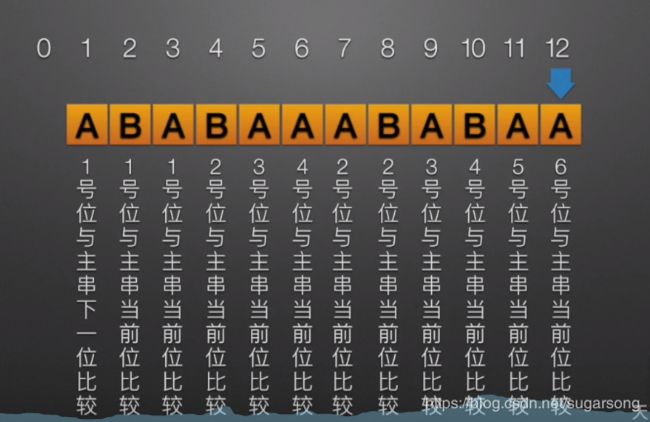KMP算法模板及理解
Number Sequence
Given two sequences of numbers : a[1], a[2], … , a[N], and b[1], b[2], … , b[M] (1 <= M <= 10000, 1 <= N <= 1000000). Your task is to find a number K which make a[K] = b[1], a[K + 1] = b[2], … , a[K + M - 1] = b[M]. If there are more than one K exist, output the smallest one.
Input
The first line of input is a number T which indicate the number of cases. Each case contains three lines. The first line is two numbers N and M (1 <= M <= 10000, 1 <= N <= 1000000). The second line contains N integers which indicate a[1], a[2], … , a[N]. The third line contains M integers which indicate b[1], b[2], … , b[M]. All integers are in the range of [-1000000, 1000000].
Output
For each test case, you should output one line which only contain K described above. If no such K exists, output -1 instead.
Sample Input
2
13 5
1 2 1 2 3 1 2 3 1 3 2 1 2
1 2 3 1 3
13 5
1 2 1 2 3 1 2 3 1 3 2 1 2
1 2 3 2 1
Sample Output
6
-1
原文翻译
给定两个数字序列:一个[1],一个[2],……, a[N],和b[1], b[2],, b[M] (1 <= M <= 10000, 1 <= N <= 1000000)你的任务是找到一个数字K,使a[K] = b[1], a[K + 1] = b[2],……, a[K + M - 1] = b[M]。如果有超过一个K,输出最小的那个。
输入
输入的第一行是一个数字T,表示大小写。每个case包含三行。第一行是两个数字N和M (1 <= M <= 10000, 1 <= N <= 1000000)。第二行包含N个整数,表示一个[1],一个[2],……[N]。第三行是M个整数,表示b[1], b[2],……,b [M]。所有整数都在[-1000000,1000000]的范围内。
输出
对于每个测试用例,您应该输出一行只包含上面描述的K。如果不存在这样的K,则输出-1。
样例输入
2
13 5
1 2 1 2 3 1 2 3 1 3 2 2
1 2 3 3
13 5
1 2 1 2 3 1 2 3 1 3 2 2
1 2 3 2 1
样例输出
6
1
题目大意
这是一道KMP的板子题。其实很好理解。就是让找字符串 a 中
是否存在与字符串 b 完全相同的字符串片段。也可以理解为 a 中是否存在 b 。
解题思路
可以用最简单的幼稚算法。以 a 为参照 ,将字符串 b 一个一个的和 a 对照。如果不一样的话那么就让 b 从第一个开始,再把 a 往后移一位继续一个一个对照。但是这样很麻烦,并且很慢,很容易 T 。所以就要用KMP算法来优化运算。
KMP算法理解


第一个图里就是先逐个对比,当发现不匹配的字符之后,用KMP算法可找到最长公共前后缀“AB”。可不动指针位置,移动前缀至后缀位置即可。

为什么可以这么移动?就是因为在前缀和后缀之间不会存在完全配对的情况,所以可以直接跳过节省时间,节省运算。这是KMP的核心部分。

值得注意的是,前后缀的公共部分可以交叉。如上图, “ABABA” 的最长公共前后缀为 “ABA” 。
接下来我们可以考虑如何确定这个指针的位置。通过下图分析可知,需要被匹配的字符串可以通过自身来确定位置。

化成表格可得:

而这个就是kmp算法中的关键部分 —— next 数组
代码实现
以本篇例题为例
#include
// printf("%d ",nextt[i]);
// printf("\n");
}
void kmp()
{
int i=0,j=0;
int flag=0;
init();
while(i<n)
{
if(j==-1||a[i]==b[j]) // 对比配对
{
j++;
i++;
}
else j=nextt[j]; //出现不配对,把前缀移动至后缀位置。
if(j==m)
{
flag=1;
printf("%d\n",i-m+1);
break;
}
}
if(flag==0)printf("-1\n");
}
int main()
{
int ttt;
scanf("%d",&ttt);
while(ttt--)
{
scanf("%d%d",&n,&m);
for(int i=0;i<n;i++)
scanf("%d",&a[i]);
for(int j=0;j<m;j++)
scanf("%d",&b[j]);
kmp();
}
return 0;
}
总结
KMP算法 思想比较好理解一些,但是需要好好看代码。这个代码理解起来确实有点难。next数组的运用比较灵活,如果理解并能灵活运用next数组的话,KMP算法就没太大的难点了。
多做一些练习即可。
KMP视频讲解链接
KMP算法动态讲解(不含代码)